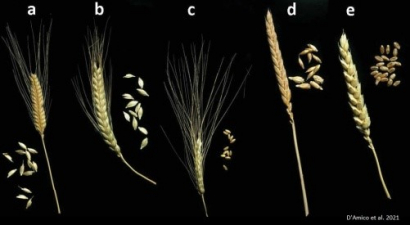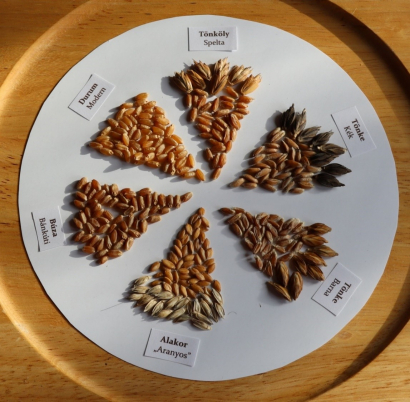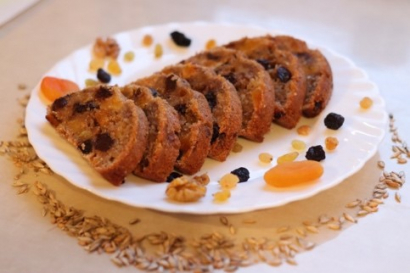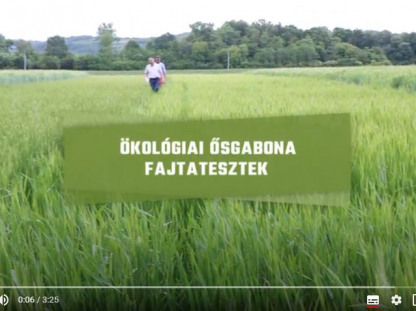The nutritional value of ancient wheats
Gyöngyi Györéné Kis
A look at the history of ancient grains
If this was a fairy tale, we might begin by saying that once upon a time, long, long ago (about three million years ago) there lived an ancient einkorn. This einkorn, which may still have appeared quite similar to a grass, at one point happened to cross with a goatgrass, which was even more like a grass. It was from this pairing, however, that wild emmer, the ancestor of the domesticated and currently cultivated emmer, was born. Although the einkorn or ‘single-grain’ wheat cultivated today is not a direct participant in this story, as it is only a cousin to the ancient einkorn, which begins the tale, the genetic connection between them is close. However, the family saga is not yet over, because the emmer, which prehistoric man had already begun to cultivate and select for on his land, interbred with another goatgrass, and thus spelt (which is also considered an ancient wheat) was formed, from which today's bread wheat later developed.
The einkorn, emmer and spelt grown today still retain some of their ancient grass type characteristics, so for instance their strong glumes enclose the grains, and can only be removed by dehulling. In other words, they are not bare-grained like bread wheat or durum wheat which belongs to the same species as emmer but represents a different sub-species. (Figure 1).

Figure 1. Characteristics of the most common ancient and modern wheat species (a: einkorn, b: emmer, c: durum, d: spelt, e: bread wheat). [1]
Why are ancient wheats valuable?
Since ancient times, wheat has been one of our most widespread crops and nutrient sources. It has been a symbol of abundance and fertility in the customs of the peoples of the Earth since prehistoric times [2]. In recent years, there has been a growing interest in rediscovering more natural foods, sustainable farming methods, and ancient foods and flavours, including forgotten cereal species. This is due in part to the fact that these ancient wheats have been less affected by modern breeding despite the past ten thousand years; they have retained their ancient features. In addition, due to their favourable cultivation characteristics, they are less demanding regarding environmental conditions, while they possess excellent disease resistance, and also have a beneficial nutritional profile.
In gastronomy we may also encounter the term farro. Farro does not refer to a single species, but means ‘ancient wheat grain’ in Italian, and is often used to refer to einkorn, emmer, and spelt collectively:
- Einkorn: known as farro piccolo in Italian, or scientifically Triticum monococcum subsp. monococcum.
- Emmer: farro medio in Italian, scientifically Triticum turgidum subsp. dicoccum.
- Spelt or Dinkel in German, farro grande in Italian, scientifically Triticum spelta.
The physiological impacts of wholegrain farro cereals are not only not worse than those of today's bread wheat, they may even be more nutritious. Below we take a closer look at the most valuable properties of einkorn and emmer.
They are extremely nutritious
Cereals have played a crucial role in nutrition for millennia, supplying the basic carbohydrate and protein needs of the human body. One of the advantages of cereals over other crops is that the proportion of nitrogenous to nitrogen-free substances (oil, minerals, B vitamins, vitamin E) in their grains is beneficial. Consequently, cereals lack only a few physiologically important nutrients (such as vitamin C) but these can be found in other foods. Their grains are rich in energy (carbohydrates), are easy to store, easy to transport, relatively easy to process, and have a wide range of uses [3]. The domestication of wheat, and the subsequent breeding efforts, have resulted in large yield increases over the past two centuries, but have been accompanied by a deterioration in the quality of the grain and a decrease in vitamin and mineral content [4]. Intensive crop production has therefore led to changes in the nutrient composition of crops. Unfortunately, the pursuit of increased yield and productivity has also led to a deterioration in the taste properties of modern wheat.
Ancient wheats are extremely nutritious cereals. They are excellent sources of protein, fibre, and nutrients (due to their magnesium, zinc, and vitamin B content, for example) and can therefore be healthier alternatives to either white rice or other refined grains.
Rich sources of protein with a beneficial protein composition
Proteins are very important components of living cells, so they are of particular importance in nutrient consumption. When it comes to macro-nutrients, the protein content of the ancient wheat species, such as emmer and einkorn, is higher than that of modern wheat. Research conducted abroad found 33-36% higher protein content values in these two ancient wheats [5]. ÖMKi's experiments to date have yielded similar results: in both 2018 and 2019, the protein content of the tested emmer and einkorn varieties ranged between 16-20%, and was between 12-18% in 2020. In addition, the amino acid composition of ancient wheats is generally more favourable, with an especially high content of essential amino acids, lysine in particular. Several sources report a lower gluten content in white flour, but our measurements did not support this finding. Higher wet gluten contents were found in emmer and in some einkorn accessions than in the control wheat varieties, due to the very high water absorption capacity of their flour.
As their gluten composition is very different from that of modern wheat, studies have shown that ancient wheats are less toxic; they cause allergic reactions in fewer people than classic bread wheat. However, given that ancient wheats also contain gluten, though in different compositions, they are not suitable for people with coeliac disease or gluten sensitivity. The high protein content, on the other hand, can be useful for those who want to take in more plant-based proteins or follow a vegetarian or vegan diet.
Sources of suitable, easily digestible fibres
A diet rich in fibres contributes to healthy digestion, and can carry “good” bacteria into the gut, which has been shown to be beneficial in reducing the risk of colon cancer [6]. The average fibre intake of the Hungarian adult population is below the international recommendations [7], but with a little attention this tendency could be changed. A quarter cup of cooked or wholemeal emmer provides nearly 5 grams of reliable fibre, the regular consumption of which helps ensure a balanced diet. Ancient wheats usually have a lower carbohydrate content (dietary fibre and digestible carbohydrates) than classic bread wheat (due to the high starch content of the latter). In terms of starch, einkorn contains large amounts of amylose, which slows down starch digestion. This reduces the level of glucose and insulin in human body after consumption, while satiety is maintained longer. The feeling of hunger also takes longer to return after a meal.
Fibres can also help maintain a healthy weight. A study from 2019, involving 345 people found that fibre intake helped them lose weight and follow a low-calorie diet [8]. Due to these beneficial characteristics, ancient wheats may be appropriate elements of a balanced diet.
Also suitable for people with diabetes
Ancient wheats have a low glycaemic index value, which means they do not cause an increase in blood glucose levels in the way that foods made from refined flour, such as white bread or traditional pasta, tend to do. This makes the blood glucose level more stable, which can be helpful for those who are prediabetic, or suffer from type 2 diabetes. In addition, a study has shown that some emmer varieties can help lower high blood sugar levels, due to their antihyperglycemic properties [9].
Similar results have been reported in animal experiments. A study on obese, diabetic rats revealed that the development and progression of type 2 diabetes was less pronounced just after nine weeks in the group fed with ancient wheat varieties than in the group consuming modern wheat [10]. In another study, rats that received varieties of local landrace wheats or ancient wheats were found to have a lower incidence of type 1 diabetes and related complications than those fed with modern wheat [11].
They have a favourable fatty acid composition
The lipid content of einkorn can be up to 50-62% higher, and in some types of emmer 31% higher, than in modern wheat [5, 12, 13]. It is also interesting that einkorn contains a lower proportion of saturated fatty acids, but more monounsaturated fatty acids [13]. Due to their beneficial fatty acid composition, the consumption of ancient wheats reduces the levels of total cholesterol and LDL-cholesterol in the blood, and may decrease the risk of cardiovascular disease [14].
Beneficial sources of antioxidants, vitamins and minerals
Antioxidants include several groups of compounds, including vitamins, minerals, polyphenols, carotenoids, and enzymes. Fruit and vegetables are known to be extremely rich in antioxidants. However, the role of whole grains in maintaining health is also worth noting, as they contain numerous antioxidant compounds. These include polyphenols, carotenoids, phytosterols, ferulic acid, vitamin E and selenium. As a result, they have been shown to be effective against a number of health problems arising from or associated with oxidative damage caused by free radicals. Oxidative stress has been associated with heart disease, cancer, arthritis, stroke, respiratory disease, immunodeficiency, emphysema, Parkinson's disease, and other inflammatory or ischemic conditions. Antioxidants can be said to help neutralize free radicals in our body, thereby improving overall health [15].
The total polyphenol content of ancient wheats is outstanding: it can contain up to 80% more than classic bread wheat [5]. It was also found that bound flavonoids were present in much greater amounts in einkorn grains than even in emmer, while tests for antioxidant activity also showed elevated results in einkorn [16].
Einkorn has significantly higher free and bound phenolic acid content compared to emmer and spelt. Furthermore, both einkorn and emmer can be considered valuable sources of ferulic, p-coumaric and caffeic acids. Due to their high phenolic acid content, ancient grains can make up an important part of our diet, especially in the case of einkorn, which has particularly beneficial characteristics. [17]
Both emmer and einkorn are very rich in carotenoids, especially lutein and zeaxanthin [18]. Research shows that einkorn has a higher carotene content and 3 to 10 times higher lutein content than bread wheat [13, 19, 20]. Classic bread wheat has a lower lutein content compared to einkorn, as it has been bred over the years to have a low yellow pigment content and white endosperm properties.
Both ancient wheat species also have higher free and total sterol content. Phytosterol content can be 25 times higher in einkorn than in bread wheat [21]. Phytosterols are of great importance, due to their anti-cancer and cholesterol-lowering effects.
Ancient wheats are also a valuable source of vitamins and minerals. Both macro- and micronutrients are present in a higher proportion and more concentrated form in the smaller einkorn grains. Depending on the variety and site of production, research indicates higher levels of Se, Fe, Li, Ca, K, Mg, P, Zn, Cu and Mn in ancient wheat [5, 12, 20]. With regard to vitamins, vitamin E levels in einkorn, as well as levels of vitamin B2, B6 and, in some emmer varieties, B9 are outstanding [13, 20, 22].
Research on the health effects of ancient wheats has found that, due to the high levels of polyphenols, carotenoids, lutein and vitamins E found in these species, they have beneficial anti-inflammatory and antioxidant properties [14, 23].
Culinary specialties, or what meals can we prepare with ancient wheat?
Einkorn and emmer have unique, characteristic taste profiles. They can be used to make pasta, biscuits, breads, and pastries, and can also be used to replace traditional wheat flour for various purposes in Hungarian cuisine (e.g. for thickening, or preparing a roux). Because their gluten content differs significantly from that of modern wheat, they cannot be used to make light, puffy loaves of bread. It is better to use wholemeal. After all, here as elsewhere, it’s true that "the vitamins are in the peel".
Einkorn and emmer are extremely easy to incorporate into your diet if you want to eat them in grain form. That way they can be consumed just like other popular grains such as rice, barley, oats or quinoa. They are also easy to use in salads, soups, stews, risottos, or casseroles. They can likewise be purchased in flaked form, meaning they can be eaten for breakfast, mixed with yoghurt, milk, or fresh fruit and honey.
Einkorn and emmer can also be considered specialities among producers of beer and other alcoholic drinks. In 2016, an einkorn organic beer won the Organic Product of the Year award in a competition held by the Hungarian Bioculture Association. It can also be used to make beer distillate.
Our recipes for ancient wheats, compiled together by ÖMKi and its partner artisanal bakeries that make delicious breads from emmer and einkorn, can be found on our website.
References D'Amico S., et al., 2021. Are ‘ancient wheats’ and old landraces better digestible? In: Vereinigung der Pflanzenzüchter und Saatgutkaufleute Österreichs, Tagungsband der 71. Jahrestagung der Vereinigung der Pflanzenzüchter und Saatgutkaufleute Österreichs, 15-18.; ISBN: 978-3-900932-81-7. Nyers Cs. K. Bevezetés a gabonakonyhába. Visszaadni a gabonák tiszteletét, becsületét! (Introduction to the grain kitchen. Restoring honour and respect for the grain!) Budapest, ISBN 9630040743, 139. Varga A., Györéné Kis Gy. Növénytermesztés és élelmiszerminőség. Egyetemi jegyzet, (Crop production and food quality. University paper,) SZIE MKK KTI, Szent István Egyetemi Kiadó, Gödöllő, ISBN 9789632690124, 119. Arzani, A., Ashraf, M. 2017. Cultivated Ancient Wheats ( Triticum spp.): A Potential Source of Health-Beneficial Food Products: Ancient wheats for healthy foods. Comprehensive Reviews in Food Science and Food Safety 16(3), 477-88. Boxstael, Van F. et al ., 2020. A comparison of the nutritional value of Einkorn, Emmer, Khorasan and modern wheat: wholegrains, processed in bread, and population-level intake implications, Journal Of The Science Of Food And Agriculture. 100(11), 4108-4118. Thanikachalam K, Khan G. 2019. Colorectal cancer and nutrition. Nutrients. 11(1), 164. Szűcs V. et al., 2016. Az élelmi rostokkal kapcsolatos fogyasztói ismeret – Hazai kérdőíves felmérés eredményei. Orvosi Hetilap, 157 (8), 302-309. ISSN 0030-6002. Miketinas D. C. et al., 2019. Fiber Intake Predicts Weight Loss and Dietary Adherence in Adults Consuming Calorie-Restricted Diets: The POUNDS Lost (Preventing Overweight Using Novel Dietary Strategies) Study. J Nutr. Oct 1;149(10), 1742-1748. Ashish C. et al, 2018. Ethnic food perspective of North Dakota common emmer wheat and relevance for health benefits targeting type 2 diabetes. Ethn. Foods, 5, 66-74. Thorup A.C., Gregersen S, Jeppesen PB. 2015. Ancient wheat diet delays diabetes development in a type 2 diabetes animal model. Rev Diabet Stud, 11, 245–57. Gorelick J., et al., 2017. The impact of diet wheat source on the onset of type 1 diabetes mellitus lessons learned from the non-obese diabetic (NOD) mouse model. Nutrients, 9(9), 922. Biel, W. et al. 2021. Comparison of yield, chemical composition and farinograph properties of common and ancient wheat grains, European Food Research and Technology 247, 1525–1538. Hidalgo A., Brandolini A., Ratti S. Influence of genetic and environmental factors on selected nutritional traits of Triticum monococcum. J Agric Food Chem 57, 6342–6348. Dinu, M., et al., 2018. Ancient wheat species and human health: Biochemical and clinical implications. J nutrbiochem, 52.1-9. Lugasi A., Blázovics A., 2004. Az egészséges táplálkozás tudományos alapjai. 4. számú útmutató az egészség megőrzéséhez. Széchenyi füzetek, 4., OKK OÉTI, Budapest, 132. Bencze, S. et al. 2020. Re-Introduction of Ancient Wheat Cultivars into Organic Agriculture — Emmer and Einkorn Cultivation Experiences under Marginal Conditions, Sustainability 12, 4, 1584. Baranski M. et al., 2020. The Effect of Species and Cultivation Year on Phenolic Acids Content in Ancient Wheat, Agronomy 10 (5), 673. Lachman J. et al., 2013. Tocols and carotenoids of einkorn, emmer and spring wheat varieties: selection for breeding and production. J Agric Food Chem 57, 207–14. Ziegler JU. et al., 2016. Lipophilic antioxidants in wheat (Triticum spp.): a target for breeding new varieties for future functional cereal products. J Funct Foods 20:594–605. Čurná, V. - Lacko-Bartošová, M.: 2017. Chemical Composition and Nutritional Value of Emmer Wheat. J Centr Eur Agric 18,117-134. Nurmi T. et al., 2008. Phytosterols in wheat genotypes in the HEALTHGRAIN diversity screen. J Agric Food Chem 56:9710–9715. Piironen V. et al., 2008. Folate in wheat genotypes in the HEALTHGRAIN diversity screen. J Agric Food Chem 56:9726–31. Spisni E. et al., 2019. Differential Physiological Responses Elicited by Ancient and Heritage Wheat Cultivars Compared to Modern Ones., Nutrients, 11, pp. 1 – 20.


.png)
.jpg)






